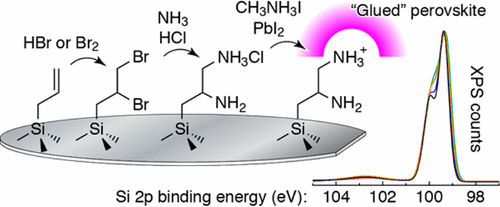当前位置:
X-MOL 学术
›
ACS Appl. Mater. Interfaces
›
论文详情
Our official English website, www.x-mol.net, welcomes your feedback! (Note: you will need to create a separate account there.)
Synthesis and Characterization of Alkylamine-Functionalized Si(111) for Perovskite Adhesion With Minimal Interfacial Oxidation or Electronic Defects
ACS Applied Materials & Interfaces ( IF 9.5 ) Pub Date : 2017-09-20 00:00:00 , DOI: 10.1021/acsami.7b07117 Alexander D. Carl 1 , Roghi E. Kalan 1 , John David Obayemi 2 , Martiale Gaetan Zebaze Kana 2, 3 , Winston Oluwole Soboyejo 2 , Ronald L. Grimm 1
ACS Applied Materials & Interfaces ( IF 9.5 ) Pub Date : 2017-09-20 00:00:00 , DOI: 10.1021/acsami.7b07117 Alexander D. Carl 1 , Roghi E. Kalan 1 , John David Obayemi 2 , Martiale Gaetan Zebaze Kana 2, 3 , Winston Oluwole Soboyejo 2 , Ronald L. Grimm 1
Affiliation

|
We investigated synthetic strategies for the functionalization of Si(111) surfaces with organic species containing amine moieties. We employed the functionalized surfaces to chemically “glue” perovskites to silicon with efficient electron transfer and minimal oxidation leading to deleterious recombination at the silicon substrate. A two-step halogenation-alkylation reaction produced a mixed allyl–methyl monolayer on Si(111). Subsequent reactions utilized multiple methods of brominating the allyl double bond including reaction with HBr in acetic acid, HBr in THF, and molecular bromine in dichloromethane. Reaction with ammonia in methanol effected conversion of the bromide to the amine. X-ray photoelectron spectroscopy (XPS) quantified chemical states and coverages, transient-microwave photoconductivity ascertained photogenerated carrier lifetimes, atomic force microscopy (AFM) quantified perovskite–silicon adhesion, and nonaqueous photoelectrochemistry explored solar-energy-conversion performance. The HBr bromination followed by the amination yielded a surface with ∼10% amine sites on the Si(111) with minimal oxide and surface recombination velocity values below 120 cm s–1, following extended exposures to air. Importantly, conversion of amine sites to ammonium and deposition of methylammonium lead halide via spin coating and annealing did not degrade carrier lifetimes. AFM experiments quantified adhesion between perovskite films and alkylammonium-functionalized or native-oxide silicon surfaces. Adhesion forces/interactions between the perovskite and the alkylammonium-functionalized films were comparable to the interaction between the perovskite and native-oxide silicon surface. Photoelectrochemistry of perovskite thin films on alkylammonium-functionalized n+-Si showed significantly higher Voc than n+-Si with a native oxide when in contact with a nonaqueous ferrocene+/0 redox couple. We discuss the present results in the context of utilizing molecular organic recognition to attach perovskites to silicon utilizing organic linkers so as to inexpensively modify silicon for future tandem-junction photovoltaics.
中文翻译:

具有最小界面氧化或电子缺陷的钙钛矿粘合用烷基胺官能化Si(111)的合成与表征
我们调查了Si(111)表面与含有胺基团的有机物种的功能化的合成策略。我们利用功能化的表面,通过有效的电子转移和最小的氧化作用将钙钛矿化学“粘合”到硅上,从而导致硅基板上的有害重组。两步卤化-烷基化反应在Si(111)上产生了一个混合的烯丙基-甲基单层。随后的反应利用了多种使烯丙基双键溴化的方法,包括与乙酸中的HBr,THF中的HBr和二氯甲烷中的分子溴反应。与氨在甲醇中的反应实现了溴化物向胺的转化。X射线光电子能谱(XPS)量化了化学状态和覆盖范围,瞬态微波光电导确定了光生载流子的寿命,原子力显微镜(AFM)量化了钙钛矿与硅的粘附力,非水光电化学探索了太阳能转化性能。溴化氢溴化后再进行胺化处理,可在Si(111)上形成具有约10%胺位的表面,且氧化物和表面复合速度的最小值低于120 cm s–1,长时间暴露在空气中。重要的是,胺位点向铵的转化以及甲基铵卤化铅通过旋涂和退火的沉积不会降低载流子的寿命。AFM实验量化了钙钛矿薄膜与烷基铵官能化或天然氧化物硅表面之间的附着力。钙钛矿和烷基铵官能化膜之间的粘附力/相互作用与钙钛矿和天然氧化物硅表面之间的相互作用相当。与非水二茂铁+ / 0接触时,烷基铵官能化的n + -Si上钙钛矿薄膜的光电化学显示,V oc明显高于具有天然氧化物的n + -Si。氧化还原夫妇。我们在利用分子有机识别将钙钛矿利用有机连接剂附着到硅上的背景下讨论当前结果,以便廉价地修饰硅以用于将来的串联结光伏。
更新日期:2017-09-20
中文翻译:

具有最小界面氧化或电子缺陷的钙钛矿粘合用烷基胺官能化Si(111)的合成与表征
我们调查了Si(111)表面与含有胺基团的有机物种的功能化的合成策略。我们利用功能化的表面,通过有效的电子转移和最小的氧化作用将钙钛矿化学“粘合”到硅上,从而导致硅基板上的有害重组。两步卤化-烷基化反应在Si(111)上产生了一个混合的烯丙基-甲基单层。随后的反应利用了多种使烯丙基双键溴化的方法,包括与乙酸中的HBr,THF中的HBr和二氯甲烷中的分子溴反应。与氨在甲醇中的反应实现了溴化物向胺的转化。X射线光电子能谱(XPS)量化了化学状态和覆盖范围,瞬态微波光电导确定了光生载流子的寿命,原子力显微镜(AFM)量化了钙钛矿与硅的粘附力,非水光电化学探索了太阳能转化性能。溴化氢溴化后再进行胺化处理,可在Si(111)上形成具有约10%胺位的表面,且氧化物和表面复合速度的最小值低于120 cm s–1,长时间暴露在空气中。重要的是,胺位点向铵的转化以及甲基铵卤化铅通过旋涂和退火的沉积不会降低载流子的寿命。AFM实验量化了钙钛矿薄膜与烷基铵官能化或天然氧化物硅表面之间的附着力。钙钛矿和烷基铵官能化膜之间的粘附力/相互作用与钙钛矿和天然氧化物硅表面之间的相互作用相当。与非水二茂铁+ / 0接触时,烷基铵官能化的n + -Si上钙钛矿薄膜的光电化学显示,V oc明显高于具有天然氧化物的n + -Si。氧化还原夫妇。我们在利用分子有机识别将钙钛矿利用有机连接剂附着到硅上的背景下讨论当前结果,以便廉价地修饰硅以用于将来的串联结光伏。



























 京公网安备 11010802027423号
京公网安备 11010802027423号